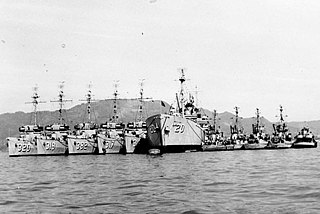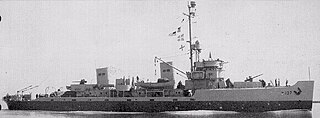
USS Gillis (DD-260/AVD-12) was a Clemson-class destroyer in the United States Navy. She was named for Commodore John P. Gillis and Rear Admiral James Henry Gillis.

USS Bunch (DE-694) was a Buckley-class destroyer escort of the United States Navy, named after Kenneth Cecil Bunch, killed in action on 6 June 1942 while flying as radioman-gunner in an SBD Dauntless dive bomber during the Battle of Midway. Bunch was a native of Norman County, Minnesota.

USS Thomas E. Fraser (DD-736/DM-24) was a Robert H. Smith-class destroyer minelayer in the United States Navy.

USS Tolman (DD-740/DM-28/MMD-28) was a Robert H. Smith-class destroyer minelayer in the United States Navy.

USS Serene (AM-300) was an Admirable-class minesweeper built for the United States Navy during World War II. She served in the Pacific Ocean and was awarded six battle stars. She was decommissioned and placed in reserve in 1946. In January 1964, the former Serene was transferred to South Vietnam as RVNS Nhật Tảo (HQ-10) in the Republic of Vietnam Navy. She was sunk in January 1974 during combat with Chinese forces in the Battle of the Paracel Islands.

USS Impeccable (AM-320) was an Auk-class minesweeper built for the United States Navy during World War II. She was originally ordered as HMS Brutus (BAM-7) for the United Kingdom's Royal Navy under Lend-Lease, but was acquired and renamed by the United States Navy before construction began. She was commissioned in 1944 and served in the Pacific before being decommissioned in 1947. After the outbreak of hostilities in Korea, Impeccable was recommissioned in 1952 and served off Korea through 1952. She was decommissioned for the final time in October 1955 and placed in reserve. She was sold for scrapping in 1974.

USS Vigilance (AM-324) was an Auk-class minesweeper acquired by the United States Navy for the dangerous task of removing mines from minefields laid in the water to prevent ships from passing.

USS Prevail (AM-107) was an Auk-class minesweeper acquired by the United States Navy for the dangerous task of removing mines from minefields laid in the water to prevent ships from passing.

USS Robin was a YMS-1-class minesweeper of the YMS-135 subclass built for the United States Navy during World War II.
USS Exploit (AM-95) was an Adroit-class minesweeper of the United States Navy. Laid down on 11 May 1942 by the Jakobson Shipyard, Inc., Oyster Bay, Long Island, New York, launched on 7 September 1942, and commissioned on 5 February 1943. The ship was reclassified as a submarine chaser, PC-1599, 1 June 1944, and reclassified again as a control submarine chaser, PCC-1599, 20 August 1945.
USS PC-1603 was a submarine chaser of the United States Navy during World War II. She was originally built and commissioned as USS Force (AM-99), an Adroit-class minesweeper. On 1 June, she was renamed PC-1603 and earned three battle stars for service in the Pacific during the war. The ship was damaged by a pair of kamikaze aircraft on 26 May 1945 and later scuttled.
USS Superior (AM-311) was a steel-hulled Admirable-class minesweeper built for the U.S. Navy in 1944. Superior participated in the final struggle in the Pacific Ocean against the Empire of Japan during the end of World War II and remained behind, after the war ended, to clear minefields laid during the war.
USS Device (AM-220) was an Admirable-class minesweeper built for the United States Navy during World War II. She was awarded three battle stars for service in the Pacific during World War II. She was decommissioned in August 1946 and placed in reserve. Although she did not see service in the war zone, Device was recommissioned in March 1950 during the Korean War and remained in commission until February 1954, when she was placed in reserve again. While she remained in reserve, Device was reclassified as MSF-220 in February 1955 but never reactivated. In October 1962, she was sold to the Mexican Navy and renamed ARM DM-11. In 1994 she was renamed ARM Cadete Agustín Melgar (C54), spelled Augustín Melgar in some sources. She was stricken in 2000, and scuttled for use as an artificial reef in Bahía de Loreto National Park.
USS Recruit (AM-285) was an Admirable-class minesweeper built for the United States Navy during World War II. She was awarded 3 battle stars for service in the Pacific during World War II. She was decommissioned in August 1946 and placed in reserve. While she remained in reserve, Recruit was reclassified as MSF-285 in February 1955 but never reactivated. In 1963, she was sold to the Mexican Navy and renamed ARM DM-07. Although she is reported out of service, her ultimate fate is not reported in secondary sources.

USS Onslow (AVP-48) was a United States Navy Barnegat-class seaplane tender in commission from 1943 to 1947 and from 1951 to 1960.

USS Lorikeet (AMS-49/YMS-271) was a YMS-1-class minesweeper of the YMS-135 subclass acquired by the U.S. Navy for the task of removing mines from water that had been placed there to prevent ships from passing.
USS Winterberry (AN-56/YN-75) was an Ailanthus-class net laying ship which served with the United States Navy in the Pacific Ocean theatre of operations during World War II. Despite being attacked near Okinawa by enemy suicide planes, she managed to return safely home after the war with the ship bearing one battle star.

USS Verdin was a YMS-1-class minesweeper of the US Navy that served during World War II. Laid down as PCS-1439 on 5 September 1943 at Jacksonville, Florida, by the Gibbs Gas Engine Co.; redesignated YMS-471 on 27 September 1943; launched on 23 May 1944; and commissioned on 27 October 1944.

USS PGM-17 was a PGM-9-class motor gunboat built for the United States Navy during World War II. She was laid down and launched as USS PC-1189, a PC-461-class submarine chaser, but was renamed and reclassified before her November 1944 commissioning. She ran aground near Okinawa in May 1945. She was salvaged a month later, but was never repaired. She was towed to deep water and sunk in October 1945.
USS PGM-11 was a PGM-9-class motor gunboat in service with the United States Navy during World War II.












